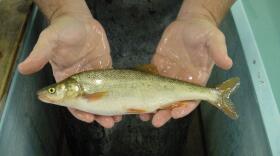The Grand Canyon, Wupatki National Monument and Sunset Crater Volcano are some of the geologic and cultural gems of the National Park Service. This summer, KNAU's Earth Notes series will highlight these, and other special places across the Southwest in honor of the Park Service's 100th anniversary. In the third installment of the series, we look at the Valles Caldera National Preserve and its ecological recovery from two massive wildfires.
New Mexico’s Valles Caldera National Preserve is one of the nation’s newest national parks. It is also a living laboratory.
Two huge wildfires raged through the landscape during the past six years, prompting a team of scientists to study their after-effects in a project called Resilient Landscapes. The project focuses in large part on fish.
Valles Caldera is located high in the Jémez Mountains, and known for its meadow-meandering fly-fishing streams. After the fires, runoff of ash and topsoil made it impossible for most fish to survive.
But some did, in part because the fire was patchy, burning some areas and not others. As waterways cleared, native fish rebounded faster than non-native brown and rainbow trout, introduced to New Mexico over a century ago. The hardy natives adapted more readily to the new conditions, but after several years the more aggressive non-natives pretty much returned to their pre-fire ratio.
This doesn’t mean things are back to normal. Until trees return to hold and shade the soil, streams carry more water, get more scoured, and hold more sediment than before. Their fish and aquatic prey reproduce and survive, but not as well as they once did — or even in the same place.
Similar studies in Yellowstone suggest that it can take 20 years or more before streams impacted by big burns resemble their old selves. Scientists say it will take long-term monitoring to know when, why, and whether a landscape as diverse as the Valles Caldera fully restores itself after an enormous fire.








